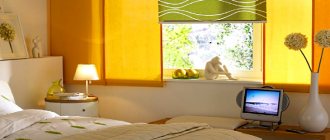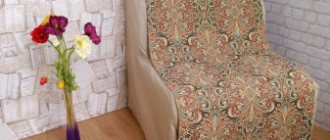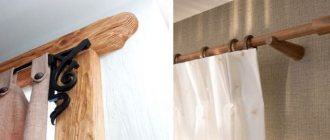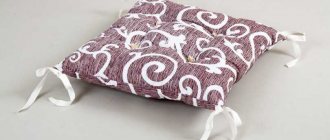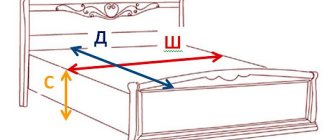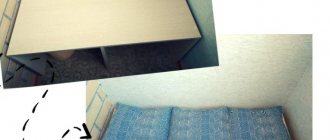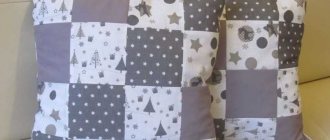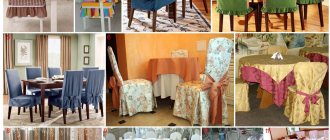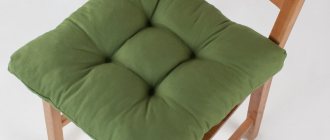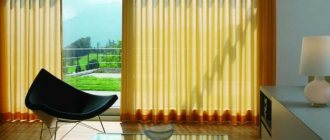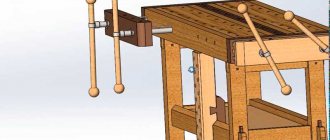The peculiarity of curtains is that they can be matched to any type of interior. They can be of various types: heavy or light, light or dark, plain or patterned, long or short, etc. There are many options available on the manufacturer market. But creating an interior for a bedroom is an individual and personal thing. Therefore, we offer the opportunity not to follow the simple path and choose the most suitable options already existing on the market, but to create your own design of curtains for the bedroom.
Beautiful curtains for the bedroom should serve a practical purpose.
DIY curtains for the bedroom: original examples, style, design for the bedroom
How to sew curtains for the bedroom with your own hands, samples of photo curtains and their diagrams are freely available. But first of all, you need to decide on several points: the color scheme of the fabric, the interior of the room and the lifestyle of its owner. Based on this, it is worth forming the image of the future product.
This room is not intended for prying eyes; here you can realize your own ideas without regard to anyone’s opinion.
Do you like the artsy baroque style? Then why not make original curtains with your own hands with figured lambrequins?
Instead of lambrequins, you can use ruffles. Only they will find application not in Baroque, but in the romantic and naive Provence style.
Country and Provence styles will add nostalgic notes to country life.
French blinds are often confused with Roman blinds. Although they have nothing in common. The French style is made entirely of lush folds, while the Roman style combines laconicism. But if you combine these two qualities, you get Austrian curtains, which are also no less popular for decorating bedrooms.
It is impossible not to mention the immortal classics in the form of curtains. They are suitable for any type of interior due to their shape, which can be repeated on any fabric.
Playing with unusual color combinations, you can make another version of curtains with your own hands, called “color block”.
The classic style is suitable for lovers of stability and constancy.
Japanese curtains are not quite the correct definition. They are more like elastic panels. The creation of such curtains requires expensive fabrics.
DIY curtains photo original ideas are not limited to standard fabrics. So, for example, muslin can be taken as a basis - this is not a very practical type of curtain for bedrooms, but definitely one of the brightest for the interior.
Unusual thread curtains will add originality to your bedroom.
How to sew curtains with your own hands?
Curtains that were sewn with your own hands should be in no way inferior to purchased ones. In particular, with regard to the performance of their key functions, namely: regulating lighting and limiting the visibility of the room from prying eyes. To achieve this, you need to know the entire technology of creating curtains: from the process of choosing fabric to sewing it.
The first step in sewing curtains for the bedroom is making a decision and getting rid of doubts.
Sewing a lambrequin: from creating a pattern to forming the finished product
Materials and tools for sewing:
- base material;
- lining fabric;
- nuts and screws.
Decorating with tassels
First you need to create a pattern; you can find many options on the needlework website. Once the style of the curtains is known, the fabric is purchased and sewing begins.
To begin, attach the material 8 cm above the window, the distance on the side should be no more than 7 cm. This type of lambrequin can be sewn in length up to the window sill.
It is important to make the calculations correctly. For a 45 cm cornice you need 70 centimeters of material.
Trim the backing material that is used to provide rigidity. It will hold the wrinkles. Connect and pin all layers and make a seam, leaving 25 centimeters on top unfinished. Turn the product inside out and close the holes. Attach the curtain rod to the curtain and make the required number of folds, tightening them with laces.
Draping a veil
What materials are best to sew curtains for the bedroom from?
Today, fabric manufacturers offer a huge variety of fabrics. But conditionally, their entire set can be divided into three types:
- Natural;
- Synthetic;
- Mixed.
Each type meets certain characteristics. For example, fabrics made from natural materials are denser, stronger and heavier. Therefore, if the bedroom faces the sunny side, then you can confidently choose cotton or linen. Due to their density, curtains made of such fabrics will allow a minimum of sunlight into the room.
Natural materials do not fade in the sun.
For example, do-it-yourself floral curtains made of calico will be combined with the Provence style or in the interior of a child’s bedroom for a girl.
Of course, it will not be possible to make complex structures out of them, but there are synthetics for this. Fabrics that were woven from non-natural components are lighter and more transparent. Fabrics such as satin, organza, tulle in their own form. Without the use of denser materials, they are not found in bedrooms. They serve as an additional layer of fabric on windows that can be used to make decorative elements.
They give the modern, simple interior of bedrooms airiness and lightness.
A material that has recently appeared on the market is called blackout. Its structure includes three types of fabric that completely isolate the space from sunlight, cold drafts and scorching rays. The advantage of a blackout is that it not only controls the light in the room, but also maintains a constant temperature in it.
Blackout is a dense canvas that does not transmit light.
The jacquard style cannot do without velvet elements in the interior. This type of fabric is characterized by a unique shine that no synthetics can replicate. The only drawback of such curtains is that they quickly collect dust that flies in the air. And it appears in the form of gray spots on the material.
All of the above types of fabric have a wide palette of colors, shades and patterns.
Everyone can find the most suitable fabric for making curtains for their bedroom.
How to calculate fabric according to the size of the window and cornice?
After you have chosen a fabric for the bedroom that matches all the quality characteristics, you need to find out how much fabric is needed to decorate the windows. To determine the height of the curtains, you first need to decide on three components.
- What kind of cornice are you using?
- What type of fabric is attached to the cornice?
- What will be the level of the curtains in relation to horizontal surfaces?
Perhaps you should start by changing the cornice - hanging a beautiful modern example.
There are two types of cornices: wall and ceiling. Depending on the location of their installation, the length of the curtain fabric is determined. Accordingly, if the cornice is wall-mounted, then it is lower and the fabric will be shorter, but in the case of a ceiling cornice, the opposite is true.
The type of fastening to the cornice can also be very diverse. For example, a cornice can be equipped with hooks and rings through which loops of fabric are threaded. Then the length is calculated from the end of the fastening itself and another 1.5 - 2 cm is added to the resulting value, depending on the row of loops on the curtain tape. And if the cornice is presented in the form of an ordinary iron beam, through which the fabric is threaded using eyelets or tied in a knot. Then you need to measure the fabric from the bottom of the beam and add plus 20 cm to the resulting value. This fabric will be used to form ribbons for ties, as well as space for installing rings inside the fabric.
The color of the material can match the rest of the textiles, walls, or, conversely, be contrasting.
There are four options for the length of curtains for the bedroom:
- Shortened curtains should be 1 cm above the window sill;
- The average length of curtains is considered to be 10-15 cm below the window sill;
- Long curtains do not touch the floor and are 5-6 cm above it;
- Extended curtains have a full length from the fastening to the floor, and another 15-20 cm must be added to the resulting size.
The width of the curtain should be 10-15 cm less than the length of the cornice.
Important! Experts who sew curtains recommend measuring the curtains exactly according to their dimensions, and then adding 10 centimeters on each side of the fabric to finish the edges.
As for the width, it is calculated according to a special gathering factor, which is different for each type of fabric:
- Loops – 1.5 – 2;
- Eyelets – 2;
- Curtain tape – 2;
- Pencil folds – 2 – 2.5;
- Triple folds – 2;
- Buffs – 2.5.
The length of the product is selected depending on the wishes of the hostess.
Now that the coefficients are known, you can begin to calculate the width of future curtains. This can be done using one of the formulas.
- Fabric consumption in width for regular curtains = curtain rod length * gathering factor.
- Fabric consumption in width for drapery curtains = (length of cornice * gathering factor) / per number of curtains.
Important! All quantitative measurements (except for the assembly factor) are indicated in meters, not centimeters, as indicated on the steel tape measure.
There is no need to make a pattern for a curtain of the simplest cut for the bedroom.
Operating procedure
Once you have purchased the fabric and prepared all the equipment, start sewing. First of all, cut the fabric using the sketch. You need to make the pattern on the reverse side.
Synthetic fabric must be ironed before cutting. Next, it is folded, matching the edges, the edges are folded and cut into two sheets. Then each of them is cut according to the measurements. You also use the leftovers.
Side edge finishing
There are no rules on how to properly sew the side edges: determine the processing width yourself. But usually it does not exceed two or three centimeters.
First, the edges are folded inside out, ironed and pinched, then the sides are stitched.
Processing the edges from below
The fabric is pinned at the bottom about five centimeters, ironed, folded in another five centimeters, and pinned. Then sew the bottom.
Finishing the edge from above
The fabric is folded at the top by about one and a half centimeters, ironed and stitched. Apply a tape with loops and attach it, first chopping it with the canvas. Trim and secure the edges. Next, sew the top, bottom, and then the edges. After that, tighten the thread to the desired width. Here also keep in mind that the width of the crossed panels will be more than half the cornice.
This is how the ribbon with loops is sewn.
Video on the topic:
As you can see, the process is simple: just read everything carefully, select equipment and fabric, and sew curtains. Do not forget to pay attention to the edges, iron the product after sewing.
From leftover fabric, create decor for a room or curtains; you can sew sofa cushions; they will combine furniture with textiles. You can also make tiebacks from fabric.
Of course, you can sew more complex versions of curtains or create lambrequins or combine fabrics. But first, try something simple so that failure does not ruin your interest in decorating your own home.
How to cut fabric for sewing curtains?
Cutting the fabric can be simple or complex depending on the curtain model. So, for example, curtains are a fairly simple, basic element of curtains that can be used as a basis for more complex schematic designs.
You can sew the product yourself using calculations, directly on the fabric or using a pattern.
To create a base for windows, namely curtains, you need to take measurements correctly, acquire curtain tape and learn how to carefully process the edges. And now the classic plain curtains are ready. If you cut off the bottom part of the curtains and sew fabric of a different color in its place, you get curtains in the “color block” style for any type of interior.
This is where the ease of upgrading the base ends. For more complex designs: lambrequins, ruffles, ruffles, Roman, Austrian and French curtains, special patterns are required.
The textile product must be properly processed on the front and back sides.
After cutting out all the elements, you need to process all the edges and mark the places for assembly. After this, all the parts are assembled, and a complete multi-layer composition on the windows is obtained.
A simpler version of lambrequins can be made from a regular rectangular piece of fabric. Moreover, to create assemblies you will need only one thread and a needle.
Decor elements
To add originality to your own work, you need to use your imagination and figure out how to decorate the curtain. The standard way to decorate is with a decorative frill. To do this, take a beautiful piece of fabric, the length corresponding to the curtain, mark it with a pencil using a pencil to mark any decorative shape you like, after which the frill is cut out using scissors. The edges of the frill are ironed and treated with colorless varnish to prevent the threads from unraveling.
The finished decorative element should be carefully stitched to the edge of the curtain, and the most complex elements should be sewn on by hand. To add originality, you can diversify the curtain with various accessories and decorations, which are sold in abundance at any sewing store.
Sewing curtains: equipment for sewing curtains at home with your own hands
A kit for creating curtains at home is no different from a regular seamstress kit:
- Sewing machine.
A sewing machine must have a reliable and powerful motor for the reason that even the lightest fabrics, due to the abundance of layers and gathers, can create a dense layer of material that is not so easy to break through.
When sewing a simple curtain, you need to start with a single-layer curtain.
- Iron or steam generator.
After completing the assembly of all curtain elements, you need to steam or iron them to remove unnecessary folds. To avoid damaging the fabric, burning the edges or leaving yellow stains, it is better to use a steam generator. This is especially true for synthetic fabrics, which can instantly stick to the hot surface of a regular iron.
- Scissors.
Two types of scissors should always be on hand: large scissors with long blades are designed for cutting and cutting fabrics, and small ones are necessary for processing threads.
You can complement the freely hanging canvas with tiebacks.
- Construction measuring tape.
Recommended by all seamstresses with experience working with curtain material. With its help you can measure the length and width of the canvas at the same time.
- Various needles, threads, pins.
Needed to make notches and marks for the correct assembly of curtain material.
French curtains are luxury, elegance and style.
- Crayons, pencils and A4 sheets.
Extra notes on a sheet of paper with the dimensions of the future product are never superfluous. Plus, using the same stationery, you can draw symbols and marks on the fabric.
Difficulties in cutting yourself
The self-cutting master class is conducted without basic knowledge, since there are not many difficulties.
- When placing the pattern, pin it in place so that the fabric does not move.
- Soap is not visible on all fabrics; they are used to trace the pattern, so washable felt-tip pens or chalk are used.
- They forget about allowances; they are needed so that the length of the product does not shorten.
- Use tracing paper; it is better to pin it to the material.
- Before cutting the main one, it is better to make a sketch on unnecessary fabric to make sure that you sew everything correctly.
